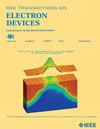A Low-Loss Flatted-Grating Folded Waveguide TWT Based on High-Phase Operating Strategy
IF 2.9
2区 工程技术
Q2 ENGINEERING, ELECTRICAL & ELECTRONIC
引用次数: 0
Abstract
A low-loss flatted-grating folded waveguide (FGFW) slow wave structure (SWS) for terahertz (THz) traveling wave tubes (TWTs) based on a novel high-phase (HP) operating strategy is proposed in this article. Compared to the conventional low-phase (LP) operation of the fundamental mode, the HP strategy significantly enlarges structural dimensions while leveraging the advantages of FGFW. High-frequency analysis demonstrates that the HP-FGFW achieves weaker dispersion characteristics, improved beam-wave synchronization, and lower ohmic loss compared to LP-FGFW. The transmission characteristics verify the effectiveness of the low-loss characteristic of HP-FGFW for the TWT. Particle-in-cell (PIC) simulations predict improvements in the amplification performance and an increase in the 3-dB bandwidth of the HP-FGFW TWT. Meanwhile, the fabrication feasibility has been verified by the nano-CNC technique. A good agreement between simulated and measured transmission characteristics was achieved, with a conductivity of 2.0 S/m. Fabrication quality evaluation showed high-dimensional accuracy with deviations within基于高相位工作策略的低损耗平板光栅折叠波导行波管
提出了一种用于太赫兹行波管(TWTs)的低损耗平板光栅折叠波导(FGFW)慢波结构(SWS),该结构基于一种新的高相位(HP)工作策略。与基本模式的传统低相(LP)操作相比,HP策略在利用FGFW优势的同时显着扩大了结构尺寸。高频分析表明,与LP-FGFW相比,HP-FGFW具有更弱的色散特性,改善了波束波同步,降低了欧姆损耗。传输特性验证了HP-FGFW低损耗特性对行波管的有效性。粒子池(PIC)模拟预测了HP-FGFW行波管放大性能的改善和3db带宽的增加。同时,通过纳米cnc技术验证了其制造的可行性。模拟传输特性与实测传输特性吻合良好,电导率为2.0 S/m。加工质量评价表明,该工艺具有较高的尺寸精度(偏差在$\pm 2~ $ mu $ m)和较低的局部表面粗糙度(0.105 nm)。总体而言,HP-FGFW为大功率、宽带行波管提供了一个有前途的解决方案,有效地解决了制造复杂性和欧姆损耗的问题。
本文章由计算机程序翻译,如有差异,请以英文原文为准。
求助全文
约1分钟内获得全文
求助全文
来源期刊

IEEE Transactions on Electron Devices
工程技术-工程:电子与电气
CiteScore
5.80
自引率
16.10%
发文量
937
审稿时长
3.8 months
期刊介绍:
IEEE Transactions on Electron Devices publishes original and significant contributions relating to the theory, modeling, design, performance and reliability of electron and ion integrated circuit devices and interconnects, involving insulators, metals, organic materials, micro-plasmas, semiconductors, quantum-effect structures, vacuum devices, and emerging materials with applications in bioelectronics, biomedical electronics, computation, communications, displays, microelectromechanics, imaging, micro-actuators, nanoelectronics, optoelectronics, photovoltaics, power ICs and micro-sensors. Tutorial and review papers on these subjects are also published and occasional special issues appear to present a collection of papers which treat particular areas in more depth and breadth.
 求助内容:
求助内容: 应助结果提醒方式:
应助结果提醒方式:


